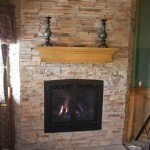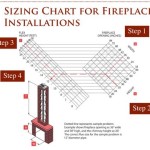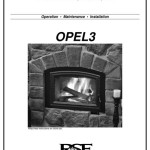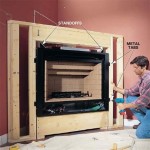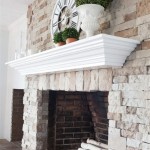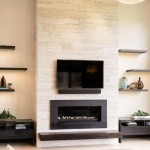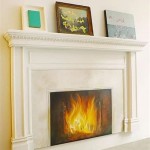Sealing A Fireplace: A Comprehensive Guide
Fireplaces, while often viewed as a source of warmth and ambiance, can also be significant contributors to energy loss in a home. An open, unsealed fireplace acts as a direct conduit to the exterior, allowing conditioned air to escape and unconditioned air to enter. This effect, particularly pronounced during colder months, leads to increased heating bills and a less comfortable living environment. Consequently, sealing a fireplace becomes a crucial aspect of home energy efficiency and overall comfort management.
Sealing a fireplace effectively involves blocking the airflow through the flue and any associated gaps within the fireplace structure itself. This process encompasses several steps, from identifying the appropriate sealing method to meticulously executing the chosen technique. The selection of the most suitable sealing method depends on factors such as the frequency of fireplace use, the type of fireplace, and individual budgetary considerations.
The benefits of sealing a fireplace extend beyond mere energy savings. A properly sealed fireplace also reduces drafts, minimizes the entry of outdoor pollutants, and helps to prevent the accumulation of unpleasant odors within the home. Furthermore, sealing can deter unwanted critters, such as insects and rodents, from entering the house through the chimney.
Key Considerations Before Sealing
Before embarking on the process of sealing a fireplace, several important considerations must be addressed. The first, and arguably most critical, is determining the frequency of future fireplace use. If the fireplace is intended for regular use, a permanent sealing solution is not advisable. Instead, a removable and reusable option should be considered. Conversely, if the fireplace is no longer in use or is only used sparingly, a more permanent sealing solution may be appropriate.
Another crucial consideration is the type of fireplace. Gas fireplaces, for instance, have different requirements and potential hazards compared to wood-burning fireplaces. Due to the complexity and potential dangers associated with gas lines, sealing a gas fireplace often necessitates the involvement of a qualified professional. Wood-burning fireplaces, on the other hand, may be sealed using a variety of DIY methods.
Finally, the construction and condition of the fireplace itself should be thoroughly assessed. Cracks or gaps in the masonry or surrounding structure can undermine the effectiveness of any sealing efforts. These areas must be properly repaired or addressed before proceeding with the primary sealing process. Neglecting these pre-existing flaws can lead to continued air leakage and negate the intended benefits of sealing the fireplace.
Methods for Sealing a Fireplace
A range of methods exists for sealing a fireplace, each offering varying degrees of effectiveness, cost, and ease of implementation. The selection of the most appropriate method depends on the individual circumstances and preferences of the homeowner. These methods can be broadly classified into temporary and permanent sealing solutions.
Temporary Sealing Solutions: These solutions are designed to be easily installed and removed, allowing for occasional fireplace use. They are ideal for fireplaces that are used seasonally or for aesthetic purposes only.
Fireplace Plugs: These inflatable plugs are designed to be inserted into the flue and inflated to create a tight seal. They are relatively inexpensive and easy to install, but they require careful monitoring to ensure that they remain properly inflated. A safety tag should always be hung on the fireplace to remind occupants that the plug is in place before attempting to light a fire.
Fireplace Draft Stoppers: These are typically made of insulated fabric or foam and are designed to fit snugly into the fireplace opening. They provide a barrier against drafts and can be easily removed when the fireplace is in use. These stoppers often come in various sizes and shapes to accommodate different fireplace designs.
Chimney Balloons: Similar to fireplace plugs, chimney balloons are inflatable devices that are inserted into the chimney flue to block airflow. They are generally larger than fireplace plugs and are suitable for sealing larger chimneys. As with fireplace plugs, it's crucial to remember to remove the balloon before lighting a fire.
Permanent Sealing Solutions: These solutions are designed to provide a more permanent barrier against airflow and are suitable for fireplaces that are no longer in use or are rarely used.
Chimney Cap: A chimney cap serves multiple purposes. It prevents rain, snow, and debris from entering the chimney, and it can also help to reduce drafts. While a chimney cap alone won't completely seal a fireplace, it is an essential component of a comprehensive sealing strategy.
Sealing the Damper: The damper is the metal plate that closes off the flue when the fireplace is not in use. Over time, dampers can become warped or damaged, allowing air to leak through. Sealing the damper involves using high-temperature silicone caulk or metal tape to seal any gaps around the damper. In some cases, the damper can be permanently closed and sealed with expanding foam.
Filling the Flue: For fireplaces that are permanently out of use, the flue can be filled with insulation to provide a complete barrier against airflow. This typically involves using fiberglass insulation batts or foam insulation to fill the flue cavity. Caution should be taken to ensure that the insulation is properly installed and does not pose a fire hazard.
Masonry Sealing: Cracks and gaps in the masonry of the fireplace can contribute to air leakage. These areas should be sealed with masonry caulk or sealant to prevent drafts. This is particularly important for older fireplaces that may have deteriorated over time.
Step-by-Step Guide to Sealing a Fireplace (Using a Fireplace Plug Example)
This example focuses on using a fireplace plug, a common and relatively straightforward method for temporary sealing. Other methods will have different specific steps, but this provides a general framework.
1. Measurement and Preparation: Before purchasing a fireplace plug, accurately measure the dimensions of the fireplace flue. This measurement will determine the appropriate size of the plug needed to create a secure seal. Clean the area around the damper and the flue opening to remove any dust, debris, or soot that could interfere with the seal.
2. Plug Insertion: Carefully insert the deflated fireplace plug into the flue opening. Ensure that the plug is centered and positioned below the damper. Some plugs may have a specific orientation, so consult the manufacturer's instructions.
3. Inflation: Use a hand pump or an electric pump to inflate the fireplace plug. Slowly inflate the plug until it fits snugly against the flue walls, creating an airtight seal. Avoid over-inflating the plug, as this could damage it or the flue. Refer to the manufacturer's instructions for the recommended inflation pressure.
4. Leak Testing: After inflating the plug, check for any air leaks around the edges. If you detect any leaks, deflate the plug slightly and reposition it before re-inflating. Ensure that the plug is properly seated and that the seal is secure.
5. Safety Tag: Attach a brightly colored safety tag to the fireplace, clearly indicating that the fireplace is sealed with a plug. This tag will serve as a reminder to remove the plug before attempting to light a fire. The tag should be prominently displayed to prevent accidental fires.
6. Periodic Inspection: Regularly inspect the fireplace plug to ensure that it remains properly inflated and that the seal is intact. Over time, the plug may lose air pressure, requiring re-inflation. Also check for any signs of damage or wear and tear. Replace the plug if it becomes damaged or ineffective.
Sealing a fireplace is a practical and cost-effective way to improve home energy efficiency and comfort. By carefully considering the options and following the appropriate steps, homeowners can effectively minimize drafts, reduce energy costs, and create a more pleasant living environment. Consulting with a qualified professional is always recommended, particularly for complex sealing projects or when dealing with gas fireplaces.

How To Block A Chimney Full Service

Fireplace Sealing Ropes And Tapes Steigner

6 Best Ways To Close Off A Fireplace Family Handyman

Fireplace Weatherstripping

Fireplace Seal Self Adhesive Sealing Tape Glass Door Stove 2meter

Air Sealing Between Chimney Framing Building Advisor

Fireplace Seal Self Adhesive Sealing Tape Glass Door Stove 2meter

Follow These Suggestions To Prevent A Drafty Fireplace

Fireplace Seal Self Adhesive Sealing Tape Glass Door Stove 2meter

Tiling Cleaning And Sealing A Fireplace In Oyster Slate Stone Maintenance

